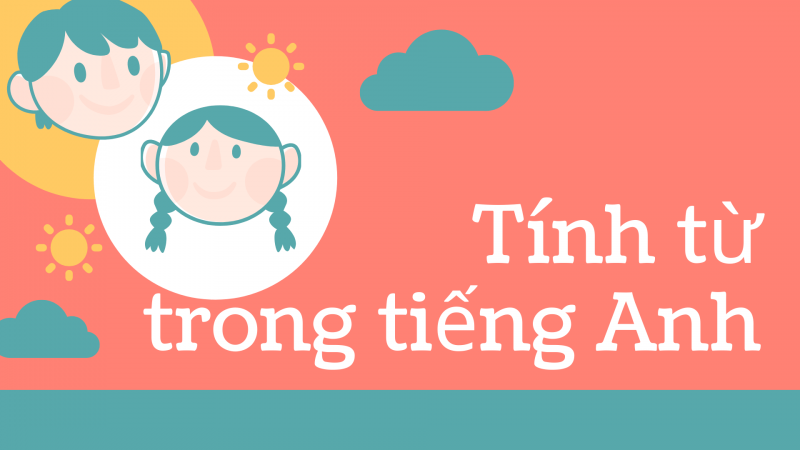Trong nhiều dạng bài tập trắc nghiệm tiếng Anh bắt buộc học sinh phải nhận biết loại từ trong tiếng anh để chọn phương án đúng. Tài liệu này sẽ cung cấp cho học sinh cách nhận biết Tính từ trong Tiếng Anh qua hậu tố, tiền tố thường gặp ở cách thể hiện và thông qua chức năng của chúng trong câu.

1. Nhận biết qua hậu tố
- Tận cùng là “able”: comparable, comfortable, capable, considerable
- Tận cùng là “ible”: responsible, possible, flexible
- Tận cùng là “ous”: dangerous, humorous, notorious, poisonous
- Tận cùng là “ive”: attractive, decisive
- Tận cùng là “ ent”: confident, dependent, different
- Tận cùng là “ful”: careful, harmful, beautiful
- Tận cùng là “less”: careless, harmless
- Tận cùng là “ ant”: important
- Tận cùng là “ic”: economic, specific, toxic
- Tận cùng là “ ly”: friendly, lovely, costly (từ này hay xuất hiện trong đề thi)
- Tận cùng là “y”: rainy, sunny, muddy (đầy bùn), windy…
- Tận cùng là “al”: economical (tiết kiệm), historical, physical…
- Tận cùng là “ing”: interesting, exciting, moving = touching (cảm động)
- Tận cùng là “ed”: excited, interested, tired, surprised…
2. Nhận biết Tính từ qua Vị trí
Tính từ (adjective, viết tắt là adj) đóng vai trò bổ trợ cho danh từ hoặc đại từ. Tính từ giúp miêu tả các đặc tính của sự vật, hiện tượng mà danh từ đó đại diện. Tính từ thường đứng sau:
2.1 Đứng trước danh từ: Adj + N
VD: My Tam is a famous singer. (trước danh từ singer)
2.2 Sau những động từ liên kết
Các động từ liên kết thường gặp: tobe/feel/look/keep/get/seem/appear + Adj
Ex:
- She is beautiful
- Ngan seems tired now.
2.3 Sau “ too”
VD: This coffee is too hot for her to drink
2.4 Trước “enough”: (adj + enough)
VD: This coffee is hot enough for me to drink.
2.5 Trong cấu trúc so…that: (so + adj + that)
VD: The weather was so bad that I decided to stay at home
2.6 Dùng trong câu so sánh
VD:
- Fish is more expensive than meat.
- Ngân is the most intelligent pupil in my class.
2.7 Trong câu cảm thán
Cấu trúc: How +adj + S + V/ What + (a/an) + adj + N
VD: What a beautiful day!
3. Bài tập tính từ
3.I. Fill in the correct form of the words in brackets
1. My bag is (big) …………… than yours.
2. This picture is (beautiful) …………… than that one.
3. She is much (good) ………………… now.
4. He works with (great) ………………… success than she does.
5. The weather this winter is even (bad) …………… than the last winter.
6. He was the (clever) …………… student of all.
7. The former half of the play is more interesting than the (late) …………… half.
8. Which is the (dangerous) …………… place in the world?
9. Huy is the (good) ………………… player of the two.
10. This is the (interesting) ………………… film I have ever watched.
3.2. Choose the correct response:
1. Jame was wearing a ________ short.
A. dirty old cotton
B. cotton old dirty
C. old dirty cotton
2. Pass me the ________ spoon, please.
A. plastic big blue
B. big blue plastic
C. big plastic blue
3. All the female students like the ________ professor.
A. handsome new British
B. British new handsome
C. new handsome British
4. He used to drive ________ motorbike.
A. a blue old Japanese
B. an old Japanese blue
C. an old blue Japanese
5. My brother married a ________ girl.
A. young beautiful French
B. beautiful young French
C. beautiful French young
6. This is a ________ play.
A. new Chinese wonderful
B. wonderful Chinese new
C. wonderful new Chinese
7. She is a ________ actress.
A. beautiful slim Italian
B. Italian beautiful slim
C. slim Italian beautiful
8. They are stored in the ________ box.
A. large blue plastic
B. blue large plastic
C. blue plastic large
9. She stand infront a ________ bar.
A. big metal brown
B. big brown metal
C. metal big brown
10. He gave her a ________ ring.
A. small British white
B. white British small
C. small white British
3.3. Gạch chân dưới tính từ trong câu và xác định nó là loại tính từ nào?
- We didn’t think that Jim was old enough for this responsibility.
- She has done an excellent job of adapting the novel for the screen.
- In a perfect world, everybody would have everything they needed.
- a man in a new black jacket and grey trousers
- Jack wakes up in a strange bedroom at this morning.
- It’s an expensive green Janpanese sport motorbike
- She’s got an absolutely lovely young face
- He makes the most amazing coffee.
- The bedroom is relatively large for this modern garden villa
- He had a firm, square jaw
3.4. Điền vào mỗi chỗ trống để tạo thành một tính từ ghép mới. Sử dụng từ điển nếu bạn cần nhé.
- ……….- eyed
- ………..-proof
- …………-minded
- …………-necked
- ………….- made
- …………..- free
- …………..- headed
KEY
3.I. Fill in the correct form of the words in brackets
1. My bag is bigger than yours.
So sánh giữa 2 chủ thể nên dùng so sánh hơn
2. This picture is more beautiful than that one.
So sánh giữa 2 vật nên dùng so sánh hơn
3. She is much better now.
tốt hơn trước kia, so sánh giữa 2 thời điểm
4. He works with greater success than she does.
So sánh hơn
5. The weather this winter is even worse than the last winter.
So sánh hơn
6. He was the cleverest student of all.
So sánh nhất giữa nhiều student (of all)
7. The former half of the play is more interesting than the later half.
So sánh hơn giữa 2 thời điểm
8. Which is the most dangerous place in the world?
So sánh nhất giữa nhiều places
9. Huy is the better player of the two.
So sánh hơn giữa 2 chủ thể
10. This is the most interesting film I have ever watched.
So sánh nhất giữa nhiều bộ phim
3.2.
1. A
2. B
3. A
4. C
5. B
6. C
7. A
8. A
9. B
10. C
3.3.
- old- age
- excellent- opinion
- Perfect- opinion
- New- opinion, black,grey- color
- Strange- opinion
- Expensive- opinion, green- color, Japanese- origin, sport- purpose
- Lovely- opinion, young- age
- Amazing- opinion
- Large- size, modern- opinion
- Square- shape
3.4.
Có rất nhiều đáp án, dưới đây là một số đáp án gợi ý, các bạn có thể tham khảo nhé:
- Brown/bright/blue…- eyed (mắt nâu/ mắt sáng/mắt xanh..)
- Fool/dust – proof (bằng chứng ngu ngốc/ chống bụi)
- Broad/narrow-minded (suy nghĩ thoáng, rộng/ hẹp hòi)
- Polo / low – necked (Polo có cổ/ cổ thấp)
- British / ready/hand – made (do Anh sản xuất/ làm sẵn/ thủ công)
- Tax / problem – free (miễn thuế/ không có vấn đề)
- Hot / pig – headed (nóng nảy/ đầu lợn)
- Kind / soft – hearted (nhân hậu, tốt bụng/ mềm lòng)
(Bài có thể có những lời dịch được dịch sát nghĩa đen của từng từ trong câu để dễ hiểu cho người tự học tiếng Anh từ đầu, nên có thể làm cho câu dịch không được hay)
